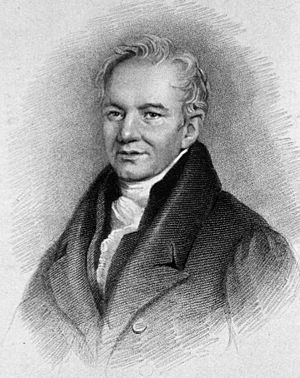Richard Pearson (physician) facts for kids
Richard Pearson (born in 1765, died on January 11, 1836) was an English doctor and writer on medical topics. He made important contributions to understanding and treating various diseases during his time.
Contents
Early Life and Education
Richard Pearson was born in Birmingham, England. He first went to school at Sutton Coldfield grammar school. After that, he started studying medicine in Birmingham with a teacher named Mr. Tomlinson.
He then moved on to the University of Edinburgh, a famous university in Scotland. There, he earned his M.D. degree (Doctor of Medicine) on June 24, 1786. While he was a student, he was chosen to be the president of two important student groups: the Royal Medical Society and the Natural History Society.
Medical Career and Travels
After finishing his studies, Pearson spent two years traveling across Europe. He visited France, Germany, and Italy with a friend, Thomas Knox, Lord Northland.
When he returned, on December 22, 1788, he became a licensed doctor with the College of Physicians of London. He started his medical practice in Birmingham. In September 1792, he became a doctor at the General Hospital there.
In 1801, Pearson left his hospital job and moved to London, where he lived in Bloomsbury Square. Later, he moved to Reading, Berkshire, then back to Sutton Coldfield, and finally returned to Birmingham. In Birmingham, he helped start a medical school, which was a big step for medical education in the city.
Richard Pearson passed away in Birmingham on January 11, 1836. He was buried at St. Paul's Chapel in the city.
Medical Writings and Discoveries
Richard Pearson was known for his many writings and ideas about medicine.
Early Achievements
While he was still a student, Pearson won a special gold medal from the Royal Humane Society. He earned it for an essay he wrote about how to tell if someone was truly dead or just in a deep faint (what was called "suspended animation" back then).
His first published work, from 1786, was about a condition called scrofula, which caused enlarged glands. He thought that using electricity might help treat these swollen glands.
Understanding Diseases
In 1795, Pearson wrote A Short Account of the Nature and Properties of different kinds of Airs so far as relates to their Medicinal Use. This book was an introduction to using different gases ("airs") to treat illnesses.
He also studied rabies, a very serious disease. In 1798, he published The Arguments in Favour of an Inflammatory Diathesis in Hydrophobia considered. In this work, he disagreed with other doctors about how rabies affected the body. He suggested different treatments, like giving wine and using special medicines far from the bite, instead of the common practice of bloodletting (removing blood).
Pearson also wrote about epidemics, which are outbreaks of disease. In 1799, he published Observations on the Bilious Fever of 1797, 1798, and 1799.
Studying Epidemics
In 1803, an influenza (flu) epidemic spread across England. Pearson wrote Observations on the Epidemic Catarrhal Fever or Influenza of 1803. This book described the symptoms of the flu and discussed how to treat it. He also noted that many people felt very sad or down after having the flu.
When an outbreak of bubonic plague happened in 1804, he quickly published Outlines of a Plan calculated to put a Stop to the Progress of the Malignant Contagion. This book offered ideas on how to stop the spread of this dangerous disease.
Medicines and Other Works
Pearson also wrote important books about medicines. In 1807, he published Thesaurus Medicaminum, which was so popular it had four editions. He also wrote A Practical Synopsis of the materia Alimentaria and Materia Medica, which was about food and medicines.
He continued to write throughout his life. In 1812, he published Account of a Particular Preparation of Salted Fish. In 1813, he wrote A Brief Description of the Plague.
Pearson also wrote articles for large encyclopedias like Rees's Cyclopædia and for magazines like the British Critic. He helped to shorten and summarize scientific papers from the Philosophical Transactions. His last known work, published in 1835, was Observations on the Action of the Broom Seed in Dropsical Affections, about using broom seeds to treat swelling.


